Developmental effect of antenatal exposure to betamethasone on renal angiotensin II activity in the young adult sheep
- PMID: 20071463
- PMCID: PMC2853307
- DOI: 10.1152/ajprenal.00497.2009
Developmental effect of antenatal exposure to betamethasone on renal angiotensin II activity in the young adult sheep
Abstract
Antenatal corticosteroids may have long-term effects on renal development which have not been clearly defined. Our objective was to compare the responses to intrarenal infusions of ANG II in two groups of year-old, male sheep: one group exposed to a clinically relevant dose of betamethasone before birth and one not exposed. We wished to test the hypothesis that antenatal steroid exposure would enhance renal responses to ANG II in adult life. Six pairs of male sheep underwent unilateral nephrectomy and renal artery catheter placement. The sheep were infused for 24 h with ANG II or with ANG II accompanied by blockade of the angiotensin type 1 (AT(1)) or type 2 (AT(2)) receptor. Baseline mean arterial blood pressure among betamethasone-exposed sheep was higher than in control animals (85.8 +/- 2.2 and 78.3 +/- 1.0 mmHg, respectively, P = 0.003). Intrarenal infusion of ANG II did not increase systemic blood pressure (P >/= 0.05) but significantly decreased effective renal plasma flow and increased renal artery resistance (P < 0.05). The decrease in flow and increase in resistance were significantly greater in betamethasone- compared with vehicle-exposed sheep (betamethasone P < 0.05, vehicle P >/= 0.05). This effect appeared to be mediated by a heightened sensitivity to the AT(1) receptor among betamethasone-exposed sheep. Sodium excretion initially decreased in both groups during ANG II infusion; however, a rebound was observed after 24 h. AT(1) blockade was followed by a significant rebound after 24 h in both groups. AT(2) blockade blunted the 24-h rebound effect among the vehicle-exposed sheep compared with the betamethasone-exposed sheep. In conclusion, antenatal corticosteroid exposure appears to modify renal responsiveness to ANG II by increasing AT(1)- and decreasing AT(2) receptor-mediated actions particularly as related to renal blood flow and sodium excretion.
Figures
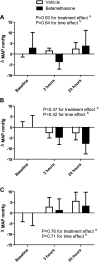
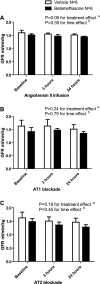
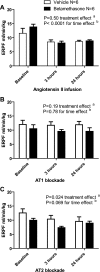
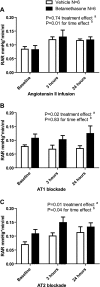
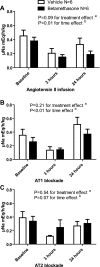
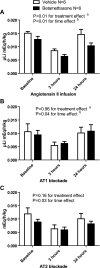
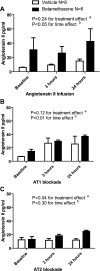
Similar articles
-
Sex-specific effect of antenatal betamethasone exposure on renal oxidative stress induced by angiotensins in adult sheep.Am J Physiol Renal Physiol. 2014 Nov 1;307(9):F1013-22. doi: 10.1152/ajprenal.00354.2014. Epub 2014 Sep 10. Am J Physiol Renal Physiol. 2014. PMID: 25209867 Free PMC article.
-
Antenatal betamethasone exposure alters renal responses to angiotensin-(1-7) in uninephrectomized adult male sheep.J Renin Angiotensin Aldosterone Syst. 2013 Dec;14(4):290-8. doi: 10.1177/1470320312465217. Epub 2012 Nov 16. J Renin Angiotensin Aldosterone Syst. 2013. PMID: 23161144 Free PMC article.
-
Angiotensin-(1-7) deficiency and baroreflex impairment precede the antenatal Betamethasone exposure-induced elevation in blood pressure.Hypertension. 2012 Feb;59(2):453-8. doi: 10.1161/HYPERTENSIONAHA.111.185876. Epub 2012 Jan 3. Hypertension. 2012. PMID: 22215705 Free PMC article.
-
Acute AT(1)-receptor blockade reverses the hemodynamic and baroreflex impairment in adult sheep exposed to antenatal betamethasone.Am J Physiol Heart Circ Physiol. 2010 Aug;299(2):H541-7. doi: 10.1152/ajpheart.00100.2010. Epub 2010 Jun 11. Am J Physiol Heart Circ Physiol. 2010. PMID: 20543085 Free PMC article.
-
Renal responses to AT1 receptor blockade.Am J Hypertens. 2000 Jan;13(1 Pt 2):45S-54S. doi: 10.1016/s0895-7061(99)00248-4. Am J Hypertens. 2000. PMID: 10678288 Review.
Cited by
-
Maternal preeclampsia and risk for cardiovascular disease in offspring.Curr Hypertens Rep. 2014 Sep;16(9):475. doi: 10.1007/s11906-014-0475-3. Curr Hypertens Rep. 2014. PMID: 25097112 Review.
-
Central ANG-(1-7) infusion improves blood pressure regulation in antenatal betamethasone-exposed sheep and reveals sex-dependent effects on oxidative stress.Am J Physiol Heart Circ Physiol. 2019 Jun 1;316(6):H1458-H1467. doi: 10.1152/ajpheart.00497.2018. Epub 2019 Apr 5. Am J Physiol Heart Circ Physiol. 2019. PMID: 30951367 Free PMC article.
-
Sex-specific effect of antenatal betamethasone exposure on renal oxidative stress induced by angiotensins in adult sheep.Am J Physiol Renal Physiol. 2014 Nov 1;307(9):F1013-22. doi: 10.1152/ajprenal.00354.2014. Epub 2014 Sep 10. Am J Physiol Renal Physiol. 2014. PMID: 25209867 Free PMC article.
-
Antenatal betamethasone exposure alters renal responses to angiotensin-(1-7) in uninephrectomized adult male sheep.J Renin Angiotensin Aldosterone Syst. 2013 Dec;14(4):290-8. doi: 10.1177/1470320312465217. Epub 2012 Nov 16. J Renin Angiotensin Aldosterone Syst. 2013. PMID: 23161144 Free PMC article.
-
Antenatal betamethasone attenuates the angiotensin-(1-7)-Mas receptor-nitric oxide axis in isolated proximal tubule cells.Am J Physiol Renal Physiol. 2017 Jun 1;312(6):F1056-F1062. doi: 10.1152/ajprenal.00593.2016. Epub 2017 Feb 22. Am J Physiol Renal Physiol. 2017. PMID: 28228403 Free PMC article.
References
-
- Barker DJP, Eriksson JG, Forsen T, Osmond C. Fetal origins of adult disease: strength of effects and biological basis. Int J Epidemiol 31: 1235–1239, 2002 - PubMed
-
- Blantz RC. The glomerular and tubular actions of angiotensin II. Am J Kidney Dis 10, Suppl 1: 2–6, 1987 - PubMed
-
- Brenner BM, Chertow GM. Congenital oligonephropathy: an inborn cause of adult hypertension, and progressive renal injury? Curr Opin Nephrol Hypertens 2: 691–695, 1993 - PubMed
-
- Burnier M. Blockade of the renin-angiotensin system for renal protection: from history to future perspectives. J Renin Angiotensin Aldosterone Syst 8: 208–211, 2007 - PubMed
Publication types
MeSH terms
Substances
Grants and funding
LinkOut - more resources
Full Text Sources
Medical
Research Materials
Miscellaneous

